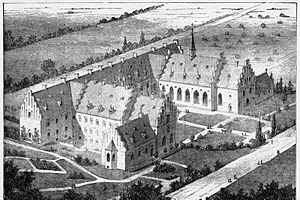Louise Conring facts for kids
Louise Martine Laurette Conring (1824–1891) was a pioneering Danish woman. She was a superintendent, hospital inspector, and nurse. She also became a deaconess, which is like a religious nurse who dedicates her life to helping others. Princess Louise asked Louise Conring to study how Deaconess Institutes worked in other countries. The goal was to start a similar place in Denmark. Louise Conring was the first Danish woman to get formal nursing training. She later became the head of the Deaconess Institute in Copenhagen starting in 1863.
Contents
Early Life and Education
Louise Conring was born on March 1, 1824, in Rungsted, Hørsholm Municipality, Denmark. Her parents were August Georg Carl Conring and Hanne Christiane Braem. As a child, Louise was often sick. She spent her winters mostly in bed at her family's home in Rendsburg. This town was then part of Danish Schleswig, where her father worked as a customs official.
During the summers, Louise stayed on her grandparents' farm in Rungsted, north of Copenhagen. Because of her poor health, she rarely went to school. Instead, her mother and other teachers taught her and her sister at home.
Becoming a Helper
From age 13, Louise Conring went to church regularly. She became even more religious after her mother passed away in 1839. During the First Schleswig War (1848–1851), she lived in Copenhagen. She enjoyed these years and met many important people. They encouraged her to help others.
Louise joined Queen Caroline Amalie's groups for nursing and child care. After living in Neustadt for a few years, she returned to Copenhagen. There, she became the director of the Børneplejeforening (Child Care Association). She was in charge of 400 children. This was the first time a woman in Denmark held such a high position. The work was hard, and she asked for help from different groups. This led her to meet Princess (later Queen) Louise.
A New Path: The Deaconess Movement
While in Neustadt, Louise Conring helped a kind person named Amalie Sieveking. Amalie worked with poor people in Hamburg. Louise also visited the Deaconess House in Kaiserswerth, Germany. This house was started by Theodor Fliedner and his wife Friederike in 1836.
Louise was very interested in the deaconess idea. It allowed women to care for the sick while also learning about religion and nursing. Following Fliedner's example, similar deaconess houses were started in Norway and Sweden.
In 1861, Princess Louise wanted to find a Danish woman to lead a deaconess center in Denmark. A pastor named Nicolai Gottlieb Blædel suggested Louise Conring. After visiting the Deaconess Institute in Stockholm, Louise accepted the job. In March 1863, she became the first Danish deaconess. Theodor Fliedner himself officially welcomed her in Kaiserswerth.
Leading the Deaconess Institute
Under Louise Conring's leadership, the first Deaconess Institute opened in Frederiksberg's Smallegade on May 26, 1863. At first, there were only four nurses, called "sisters." But the institute quickly grew. In its first two years, it cared for 63 patients and had 17 sisters.
In 1865, the institute moved to a new building. Then, in 1873, the Deaconess Institute building that stands today was opened. Louise Conring ran the institute with a very strict, old-fashioned style. She found it especially difficult to manage male patients. Two of her male colleagues even left because of this. However, her female colleagues respected her. She also softened her approach after getting advice from Queen Louise.
Louise Conring passed away in the Frederiksberg area of Copenhagen on April 1, 1891. Sophie Zahrtmann took over her role. Louise Conring left behind a very successful institution. It had a strong network of support all across Denmark.


